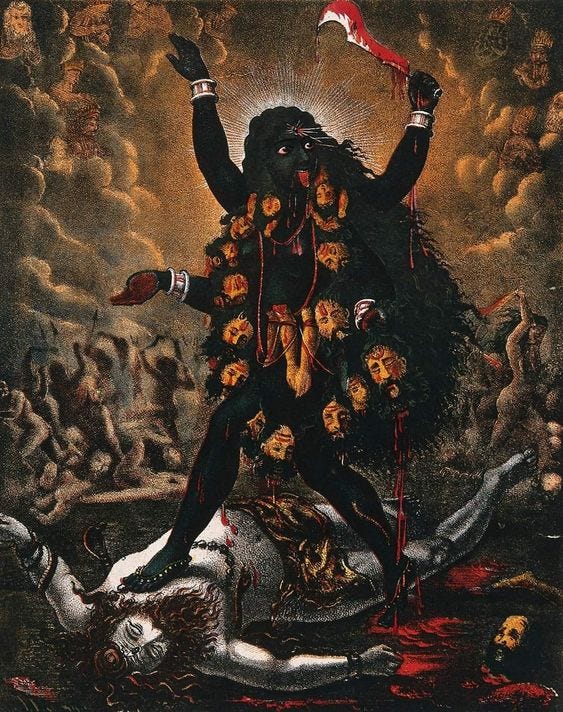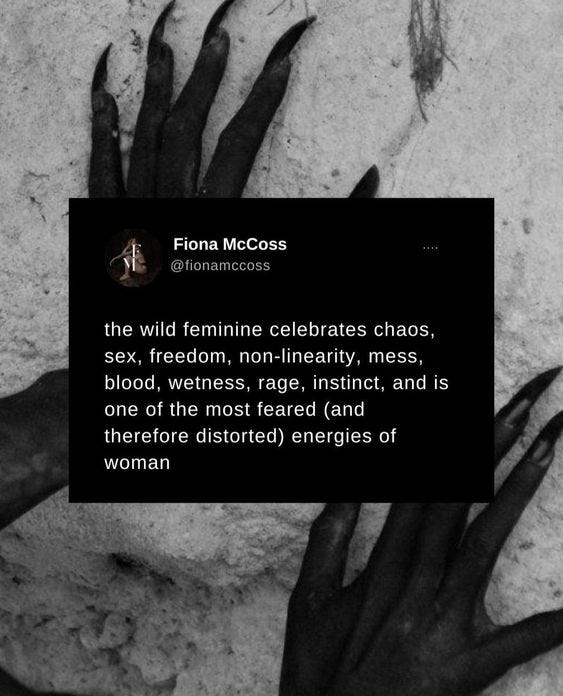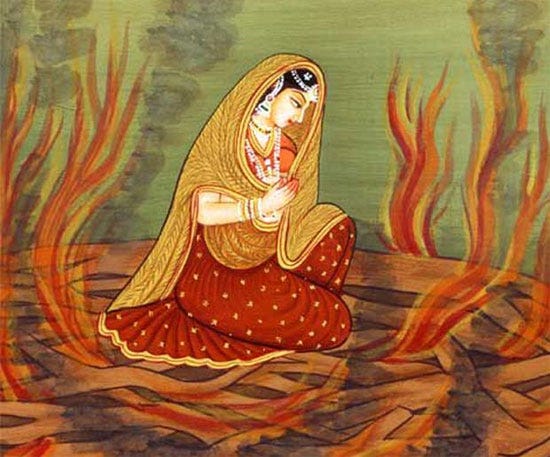Did a part of you screech inside when you saw “Bad Bitch” in the subject line of your email this morning?
That’s Kali energy waking you TF up.
This post will cut off in email - I highly recommend reading the rest on the Substack app:
In modern Hinduism, Kali is considered an avatar of Durga, whose story we covered early in
journey.The Hindu temples I went to growing up would often have Durga represented alongside her male consort Shiva, and the two other couples in the divine Triumverate - Brahma and Saraswati, Vishnu and Lakshmi.
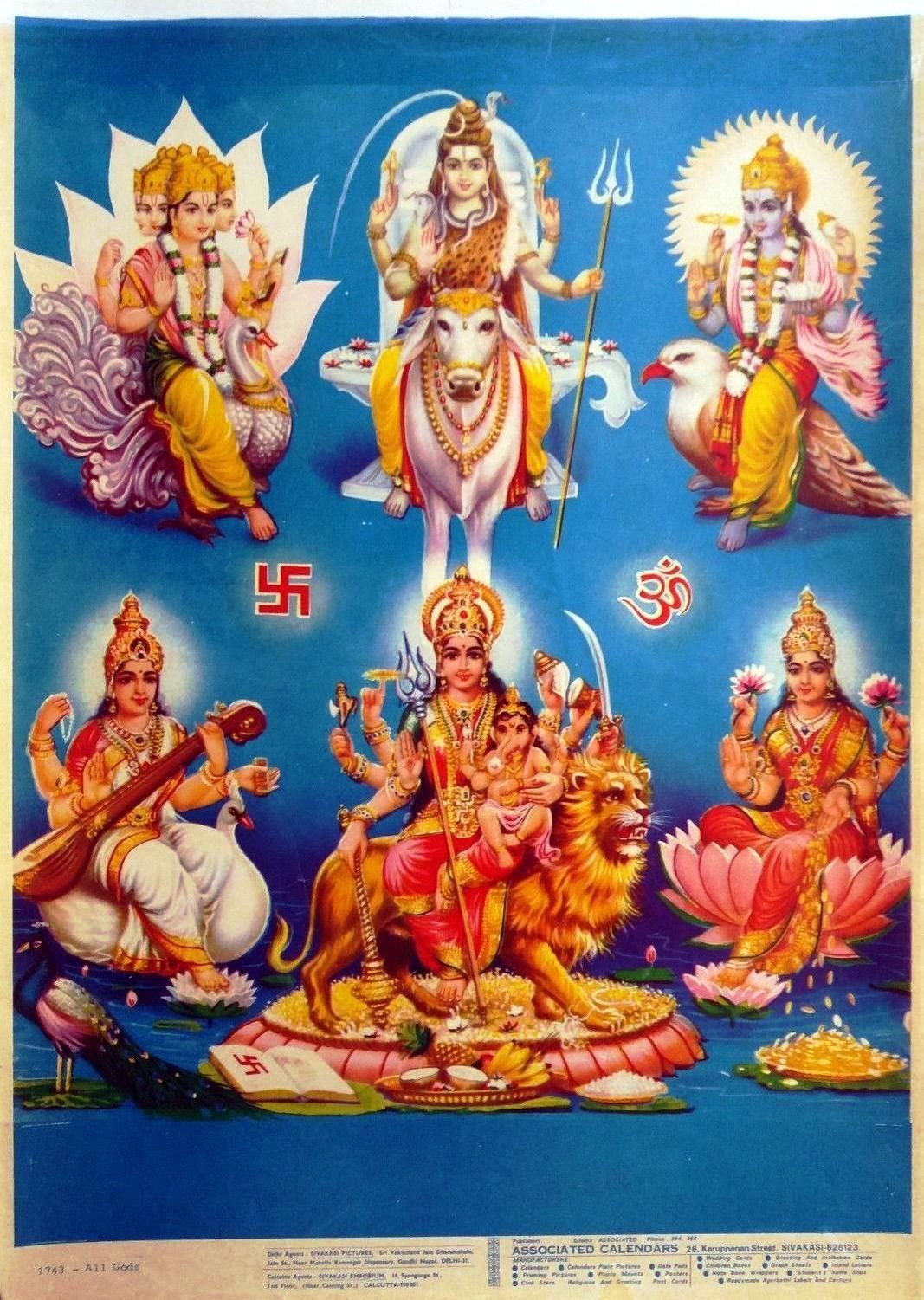
This image captures the conventional representations of Hindu deities. The types of idols you’ll most often find in temples - beautifully adorned, porcelain-skinned, and delicate.
While there is no official hierarchy among this divine trinity and while yes there is an epic 9-night celebration in the fall to worship Durga during Navratri, the large focus of Hindu mythology, contemplation, and dialogue often centers around the male representations of divinity.
People outside of Hinduism most often recognize Krishna and Rama, both avatars of Vishnu. The former is globally recognized in what is considered one of the holiest Hindu texts (the Bhagwad Gita); the latter venerated in epic poem the Ramayana.
The stories of these divine masculine gods are rooted in patriarchal values like law and order, duty, and ethics. They stories also notably have some patriarchal and misogynistic themes 🙄
Radha and Sita, Krishna’s and Rama’s divine feminine counterparts, endured tragic love stories for their beloveds. The oversimplification of their stories have been used to further a misogynistic agenda of demanding ceaselessly faithful, devoted, and submissive wives. But when we look at these stories through the lens of Shakti, we can glean profound wisdom for the radical baddie even from Radha and Sita’s sad stories. When we see their strength in their sacrifices we’re witnessing the many faces of Shakti energy.1
Kali the Dark Stranger
While Radha and Sita are considered more Yin/light feminine goddesses, Durga is firmly a Dark Feminine Goddess - she represents fierce Courage, Strength, a Goddess of War. Durga becomes the more conventionally and popularly accepted form of Kali, or Shakti energy.
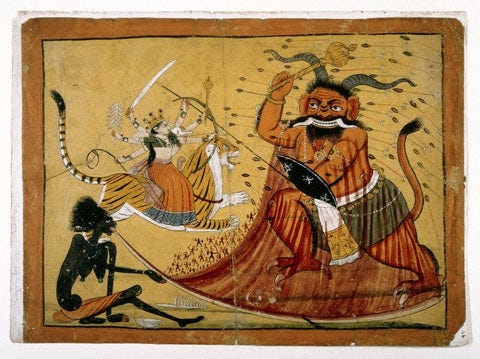
Growing up I only knew Kali peripherally. I understood there were vague associations between Kali and Durga, but didn’t know much about their relatioinship. Kali was more central in Tantric spiritual practices, therefore taboo in my community.
Her image is also frankly terrifying.
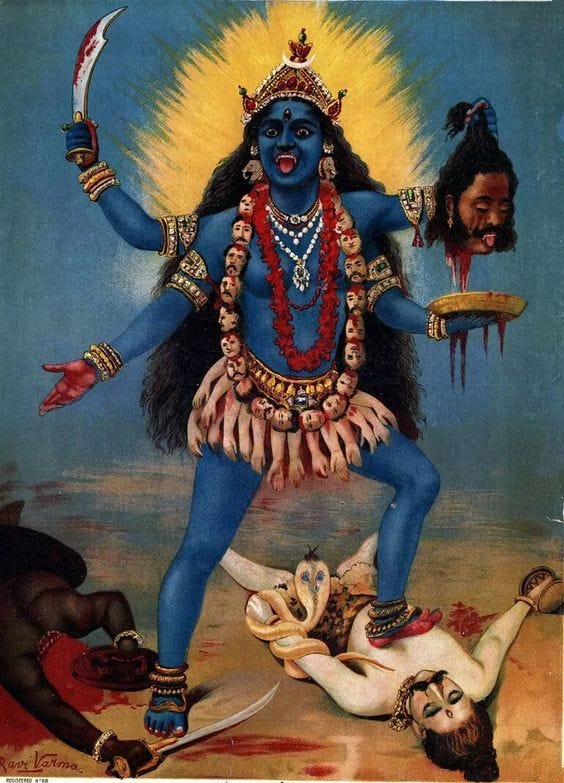
Her stories were not ones I had much access to as a child. Once in a while I’d see an image of Kali and feel sad at the thought that we were from the same culture, yet strangers. Like, she’s so mysterious and weird and interesting and cool and yet it’s this unstated rule that I won’t see her in any of my temples.
I knew instinctively how Kali was simply “too much” for the Institution.
We’ll eventually get to the critical politics of Tantra. For now I’ll just share that what is popularly known as “tantric” in the West and in the New Age Spiritual Industrial Complex is unsurprisingly a grossly reductive representation of what Tantra actually is. The sad thing is that Hindus ourselves aren’t always aware of or open about the relationship between Tantra and our Vedic, or orthodox traditions. Tantric sacred sexuality, while liberating and beautiful, has also been taken WAY out of its historical, social, and political context. This includes the mythology and meaning behind Kali.
The religion I learned did not touch any of this with a ten foot pole lol. The religion I learned had too many arbitrary rules and rigid standards for purity and morality. I felt bored at best, suffocated at worst. The culture I was raised in mirrored the religious. For most of my life, I distanced myself from both. I identified as ignorant agnostic who doesn’t purport to know anything about the spirit or mystic world.
So it truly is ICONIC that it was Kali who sparked my journey of returning back to religion and spirituality.
Like the Devil bringing you back to Church 😈
Kali has helped me reclaim parts of my religion that I still find inspiring, reinvigorated my approach to work and politics, helped me heal ancestral trauma, and returned me to folk rituals passed down in my family which do bring me comfort and joy.
CLASSIC Kali energy - absolutely nothing like what you might expect. The First BAD BITCH, the ORIGINAL RADICAL BADDIE. The energy that started it all. I’m so honored to be sharing Kali with you all this week. She’s brought me compassion, healing, humor and perspective to my life. I hope you find the same this week 🙏🏽
Shakti: Primordial Divine Feminine Energy
Durga, Kali, the Dus Mahavidyas (ten goddesses)2 - these are all aspects of Shakti. Shakti is also known across religions and cultures with different names:
Yogis know Shakti as Kundalini energy.
The South American Mayans called their serpent god Kukulcan, the Aztecs’ Quetzolcoatel, the Toltecs’ Rainbow Serpent.
The Buddhist tradition refers to an inner heat that facilitates transformation of the self.
The Church calls it Holy Spirit.
Every spiritual, mystic, indigenous tradition around the world has a relationship to Shakti energy. Shakti is the vibrational power of creation, transformation, destruction. The cycles of change. Mother Nature.
The word Shakti means ‘power.’ Shakti, the innate power in reality, has five ‘faces.’ It manifests as the power to be conscious, the power to feel ecstasy, the power of will or desire, the power to know, and the power to act.3
Visions
I was in my second year of graduate school and at very rock bottom of a health journey. As my schedule started easing up, I started a consistent yoga practice that brought me immediate relief and rejuvenation, back to the sacredness of my body.
It was also the start of a very gnarly mind-body trauma healing journey.
In the beginning, I was simply grateful to be finding ease and safety in my body in what felt like forever. Rather than be at war with my body, I was learning how to befriend her and even be on the same team as my body. Relief! Expansion! Freedom!
Around this time, I started seeing flashes in my brain of the iconic 3-eyes of Durga and Kali, my mind pulling me to her eyes glistening at me in a night sky. Out of nowhere! I was like… what is happening. What were these sensations whispering to me?
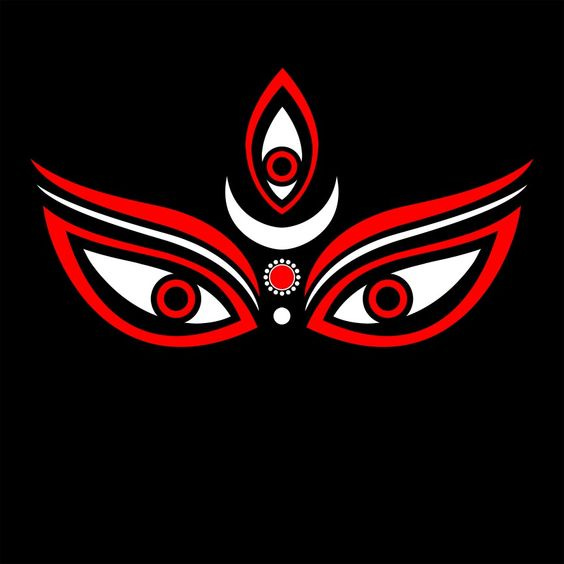
At the same time as I was having these visions and being pulled to learn more about the Midnight Goddess, I was also conducting an Independent Study in my second year of business school on Healing the World of Work.
These visions from Kali were the invitation into an off-the-books research rabbit hole that started out of purely personal intrigue but eventually would come to inform my final thesis in this year-long project. Over the next few month’s, the journey of following the blue thread unfurled led me from one new understanding to the next:
Relating to Divine Feminine/Dark Feminine, and Her many archetypes spanning culture and time.
Learning about Manifestation as a science and spiritual practice
Seeing the relationship between spirituality, indigeneity, and caste - both in my ancestral lineage as a Brahmin Hindu and in the context of Palestine-Israel
Committing to longer-term study in enrolling in Indigenous & Decolonial Feminist Ways of Knowing (even counting it towards my MBA degree which was so satisfying)
All of this, while not officially a part of my Independent Study, ended up informing my final thesis after a year of study on the question of why work sucks and how we make it better - that it’s rooted in connecting to our Soul. And we do that by reviving the Dark Feminine and understanding our lineage’s Indigenous Wisdom.
It all began through building a body-consciousness practice in Yoga that helped me find Kali when I needed Her most.
Kali ripped into my life and like the hurricane in Kansas, Kali pulled me from my dull pained stagnancy, hurtled me through the ether, and spit me out into the technicolor world of the spiritual, mystical, and the ancient.
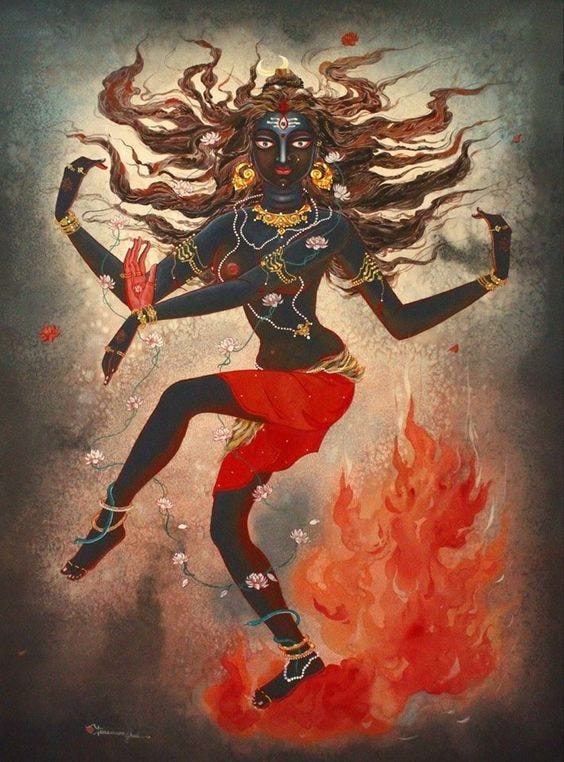
As I read about Kali and learned about this mysterious stranger, I laughed and cried at how much I needed Her in my life.
It wasn’t soon after I started seeing these visions that I started feeling the rumblings of chaos and turbulent change rippling through my life. Change, destruction, the total clearing away of old structures to make way for new blessings.
Even after I caught my breath and thought my work with Her was done for the time being, She roared back into my life and the collective’s in early October.
Kali is a Goddess for today’s time and we fail ourselves when we misguidedly associate Kali, her symbology, and story with evil. It’s through knowing and loving the terrifying face of the Dark Mother that we have the strength to face the real fuckery and evil in this world.
Thanks for riding along in this journey. Let me know if you have any questions about Kali, Tantra, or Dark Goddess mythology you’d like answered this week.
💌 tomorrow we’ll explore Kali’s story and symbology 🙏🏽🌚
In the meantime, Kali is here to remind you in case you needed it: your pain is punk rock.
Radha was hopelessly in love with notorious womanizer Krishna, who would eventually leave her in the village they came from in order to pursue a leadership position with king Arjuna, where Krishna would go on to regale Arjuna with divine wisdom that would be consumed all over world, captured in the Bhagwad Gita.
The stories of Krishna’s youth are affectionate, sweet, and full of love. Krishna is the adored divine masculine represenation of God’s irresistible beauty, charm, and allure. Naturally then, Krishna is a charmer with multiple lovers, as one of Krishna’s divine lessons is that true devotion to God allows you to bypass conventional social and religious mores.

Radha and Krishna are divine counterparts, but they don’t have a happy ending to their love story.
While Radha is passionately attached to Krishna, she knows that Krishna will never be tied down to one lover. Radha then is bittersweetly remembered for her unwavering devotion to Krishna even in her single solitude, walking the streets with other widows and women singing and chanting bhajans glorifying Krishna’s name.
While today we’d lecture Radha to get it together and stand on business, for her ceaseless devotion Radha is remembered as an icon of the Bhakti movement - teaching us to love and pleasurefully engage with divinity through all of our senses including song, storytelling, poetry, brightly colored dress, and erotic movement.
Sita’s story is even more painful and tragic. During Diwali, we light candles to help Rama and Sita return home after her long abduction by demon Ravana. Diwali is celebrated as this triumphant win of good over evil. But that’s not where the story ends! No mes amis, it’s much more tragic than this candlelit happy ending.
After surviving being kidnapped and held captive by demon Ravana for 14 YEARS, when Sita finally is rescued and returned to her husband the King, Rama, he REFUSES TO TAKE HER BACK. Rama is the pure symbol of righteous dharmic patriarchy, so Rama says it would be improper to allow Sita to return to his bed when Ravana must have slept with her 😫 Sita, aghast at holding out all this time due to her love for her husband, only to have her faith unseen, goes through additional trials and tribulations to prove her purity. Even though she successfully demonstrates her fidelity, Rama never is able to get over the gossip, and he eventually banishes her to the forest.
Years later, Rama will meet his twin sons, now strong young men, while hunting in the forest. He tells their mother Sita he’ll take her back - *if* she’ll endure one more test. Sita prepares her test - she calls out to and petitions her mother, the Earth, to receive her if Sita has been pure and faithful to Rama this whole time. A throne emerges from the Earth, Sita sits on it, and disappears never to be seen again. Rama mourns the loss of Sita for the rest of his life and never remarries.
Rama’s descendants for thousands of years would go on to maintain patriarchal domination and control, while upholding the ,ethics of duty and honor that were central to the masculine warrior-king culture. Sita’s disappearance then can be interpreted too as the sending of the divine feminine into the shadow.
While I’d often rolled my eyes at this story and the celebration of Sita’s martyrdom, I recently changed my perspective through learning more about the wisdom in Sita’s mystic submission. I really was moved by this passage from Awakening Shakti on Sita:
“The yin aspect of the feminine, like the fertile Earth, doesn’t fight to protect herself. Fierce goddesses- like Durga and Kali - fight to protect the world, to protect the gods, to protect life. The gentle goddesses simply withdraw… In human politics the only power of the truly powerless is to appeal to the moral sense of the powerfu.
Sita’s tactic would become the underpinning of Gandhi’s satyagraha movement, the American civil rights movement, and the Argentinian Mothers of the Disappeared. All these social revolutions employed the essentially feminine tactic of passive resistence to arouse the higher values of an unconsciously cruel dominating power. It’s a tactic that doesn’t work against conscious cruelty, as Winston Churchill pointed out when Gandhi suggested Britain try nonviolent resistance against Hitler. Demonic powers are not convinced by righteous displays of nonviolence, and as a personal tactic, passive resistance easily turns into passive aggression….
[However] in a world where women can still be bought and sold, where brides are set on fire because they haven’t brought enough dowry, and where women and girls are oppressed by rigid religious laws, or raped in acts of war - the loving, receptive, suffering image of Sita has enormous relevance. Ravana is still kidnapping Sita and Rama is still punishing her for having been kidnapped. Unlike Kali, who storms forth from the earth as a volcano or earthquake or tornado, Sita is herself the sacrifice.
She represents the sacred Earth which continues to bring forth crops and support life even as her pastures are paved with concrete and her life sustaining rainforests are cut down.
Sita then is a pure representation of divinity in her ability to embody unconditional love in the face of senseless violence. Sita is in the martyrs of Palestine, in all who endure unjust violence with unwavering faith and love in their hearts. Here too, even stories of submission and tragedy have wisdom and insight to offer us if we’re willing to look closely enough at that which is painful and difficult. Sita teaches us to endure the principled pains in our life with dignity and grace.
The Dus Mahavidyas begin with Kali, the supreme Deity, and also includes goddess icons that familiar representations of the Divine Feminine that reside in our collective unconscious - archetypes that show up across culture and time. Tara, Neel (blue) Saraswati, holds great importance in the Buddhist tradition as a wise and compassionate deity. Bhuvaneshwari is Goddess as World Mother, not unlike Gaia from the Pagan tradition or Mother Nature in indigenous traditions. Old smoky Dhumavati is the Widow Goddess or Goddess of Death, very similar to the Crone archetypes of Baba Yaga and Hecate.
Awakening Shakti by Sally Kempton. One of my favorite manuals with tantric nondual profiles of the Hindu pantheon of goddesses.



